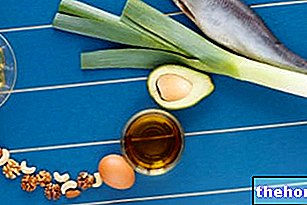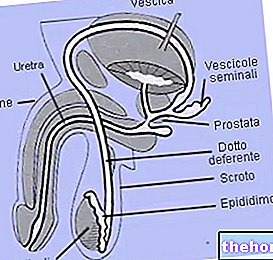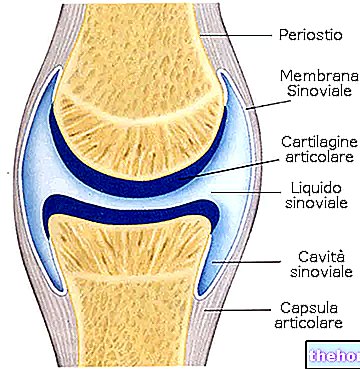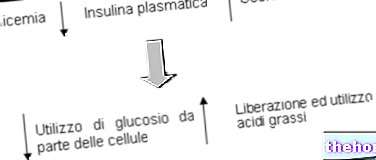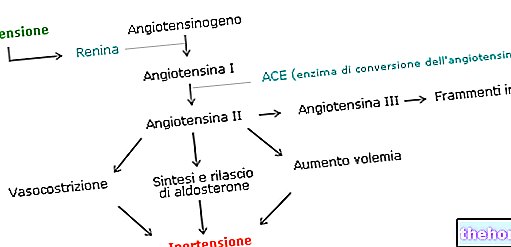
The elemental analysis of proteins gives the following average values: 55% of carbon, 7% of hydrogen and 16% of nitrogen; it is clear that the proteins differ from each other, but their average elemental composition differs little from the values indicated above.
Constitutionally, proteins are macromolecules formed from natural α-amino acids; the amino acids join through the amide bond which is established by the reaction between an amino group of an a-amino acid and the carboxyl of another a-amino acid.
This bond (-CO-NH-) is also called a peptide bond since it binds peptides (amino acids in combination):
the one obtained is a dipeptide because it is made up of two amino acids. Since a dipeptide contains a free amino group at one end (NH2) and a carboxyl at the other (COOH), it can react with one or more amino acids and lengthen the chain both from the right and from the left, with the same reaction seen above.
The sequence of reactions (which, moreover, are not really that simple) can continue indefinitely: until there is a polymer called polypeptide or protein. The distinction between peptides and proteins is linked to the molecular weight: usually for molecular weights higher than 10,000 we speak of proteins.
Binding amino acids together to obtain even small proteins is a difficult task, although recently an automatic method of producing proteins from amino acids has been developed which gives excellent results.
The simplest protein, therefore, is made up of 2 amino acids: by international convention, the ordered numbering of amino acids in a protein structure starts from the amino acid with the free a-amino group.
coding for this protein) which encounters non-negligible chemical difficulties.
It was possible to determine the ordered sequence of amino acids through Edman degradation: the protein is reacted with phenylisothiocyanate (FITC); initially the α-amino nitrogen doublet attacks the phenylisothiocyanate forming the thiocarbamyl derivative; subsequently, the obtained product cyclizes giving the phenylthiohydantoin derivative which is fluorescent.
Edman has devised a machine called a sequencer that automatically adjusts the parameters (time, reagents, pH, etc.) for degradation and provides the primary structure of proteins (for this he received the Nobel Prize).
The primary structure is not sufficient to fully interpret the properties of the protein molecules; it is believed that these properties depend, in an essential way, on the spatial configuration that the protein molecules tend to assume, folding in various ways: that is, assuming what has been defined as secondary structure of proteins.
The secondary structure of proteins is flickering, that is, it tends to disintegrate by heating; then the proteins denature themselves, losing many of their characteristic properties. In addition to heating above 70 ° C, denaturation can also be caused by irradiation or by the action of reactants (from strong acids for example).
The denaturation of proteins due to the thermal effect is observed, for example, by heating the egg white: it is seen to lose its gelatinous appearance and turn into an insoluble white substance. However, the denaturation of proteins leads to the destruction of their secondary structure, but leaves their primary structure unaltered (the concatenation of the various amino acids).
Proteins take on the tertiary structure when their chain, although still flexible despite the bending of the secondary structure, folds in such a way as to originate a contorted three-dimensional arrangement in the shape of a solid body. Responsible for the tertiary structure are above all the disulfide bonds that can be established between the cysteine -SH scattered along the molecule.
The quaternary structure, on the other hand, belongs only to proteins formed by two or more subunits. Hemoglobin, for example, is composed of two pairs of proteins (that is, in all four protein chains) located at the vertices of a tetrahedron so as to give rise to a spherical structure; the four protein chains are held together by forces ionic and non-covalent bonds.
Another example of a quaternary structure is that of insulin, which appears to be made up of as many as six protein subunits arranged in pairs at the vertices of a triangle at the center of which are two zinc atoms.
Fibrous proteins
They are proteins with a certain rigidity and having a much longer axis than the other; the fibrous protein present in greater quantities in nature is collagen (or collagen).
A fibrous protein can assume different secondary structures: α-helix, β-sheet and, in the case of collagen, triple helix; α-helix is the most stable structure, followed by the β-sheet, while the least stable of the three is the triple helix.
right if, following the main skeleton (oriented from bottom to top), a movement similar to the screwing of a right-hand screw is carried out; while the helix is of left hand if the movement is analogous to the screwing of a left-handed screw. In the right-hand α-helices the -R substituents of the amino acids are perpendicular to the main axis of the protein and are facing outwards, while in the left-hand a-helices the -R substituents face inwards. Right-handed a-helices are more stable than left-handed ones because between the vati -R c "there is less interaction and less steric hindrance. All the a-helices found in proteins are dextrorotal.
The structure of the α-helix is stabilized by the hydrogen bonds (hydrogen bridges) that are formed between the carboxyl group (-C = O) of each amino acid and the amino group (-NH) found four residues later in the linear sequence.
An example of a protein having an α-helix structure is hair keratin.
By lengthening the α-helix structure, the transition from α-helix to β-sheet is carried out; also the heat or the mechanical stress allow to pass from the α-helix to the β-sheet structure.
Usually, in a protein, the β-sheet structures are close to each other because inter-chain hydrogen bonds can be established between portions of the protein itself.
In fibrous proteins, most of the protein structure is organized in an α-helix or β-sheet.
Globular proteins
They have an almost spherical spatial structure (due to the numerous changes in direction of the polypeptide chain); some portions of being can be traced back to an α-helix or β-sheet structure and other portions are not, instead, attributable to these forms: the arrangement is not random but organized and repetitive.
The proteins referred to up to now are substances of a completely homogeneous constitution: that is, pure sequences of combined amino acids; such proteins are said simple; there are proteins made up of a protein part and a non-protein part (prostate group) called proteins conjugate.
, in the nails, in the cornea and in the lens of the eye, between the interstitial spaces of some organs (eg liver) and so on.
Its structure gives it particular mechanical capabilities; it has great mechanical strength associated with high elasticity (eg in tendons) or high rigidity (eg in bones) depending on the function it has to perform.
One of the most curious properties of collagen is its constitutive simplicity: it is made up of about 30% of proline and about 30% of glycine; the other 18 amino acids only have to share the remaining 40% of the protein structure. The amino acid sequence of collagen is remarkably regular: for every three residues, the third is glycine.
Proline is a cyclic amino acid in which the R group binds to the α-amino nitrogen and this gives it a certain stiffness.
The final structure is a repetitive chain having the shape of a "helix; within the collagen chain, hydrogen bonds are absent. Collagen is a "left hand helix with a pitch (length corresponding to one turn of the helix) greater than the" α-helix; the collagen helix is so loose that three protein chains are able to wrap around each other forming a " single rope: triple helix structure.
The triple helix of collagen is, however, less stable than both the α-helix and the β-sheet structure.
Let's now see the mechanism by which collagen is produced; consider, for example, the rupture of a blood vessel: this rupture is accompanied by a myriad of signals with the aim of closing the vessel, thus forming the clot.
Coagulation requires at least thirty specialized enzymes. After the clot it is necessary to continue with the repair of the tissue; cells close to the wound also produce collagen. To do this, first the expression of a gene is induced, that is, organisms that starting from the information of a gene are able to produce the protein (the genetic information is transcribed on the mRNA which leaves the nucleus and reaches the ribosomes in the cytoplasm where the genetic information is translated into protein). Then the collagen is synthesized in the ribosomes (it looks like a "left hand helix composed of about 1200 amino acids and having a molecular weight of about 150,000 d) and then accumulates in the lumens where it becomes a substrate for enzymes capable of carrying out post-translational modifications (modifications of the language translated by "mRNA); in collagen, these modifications consist in the hydroxylation of some side chains, especially proline and lysine.
The failure of the enzymes that lead to these changes causes scurvy: it is a disease that initially causes the breaking of blood vessels, breakage of the teeth which can be followed by interintestinal hemorrhages and death; it can be caused by the continuous use of long-life food.
Subsequently, due to the action of other enzymes, other modifications occur which consist in the glycosidation of the hydroxyl groups of proline and lysine (a sugar binds to the oxygen of the OH); these enzymes are found in areas other than the lumen therefore, the protein, while undergoing modifications, migrates inside the endoplasmic reticulum to end up in sacs (vesicles) that close on themselves and detach from the reticulum: inside them it is contained the glycosidated pro-collagen monomer; the latter reaches the Golgi apparatus where particular enzymes recognize the cysteine present in the carboxy terminal part of the glycosidated pro-collagen and cause the different chains to approach each other and form disulfide bridges: In this way, three chains of glycosidated pro-collagen are obtained linked together and this is the starting point of which the three chains, interpenetrating, then, spontaneously, give rise to the triple helix. The three chains of glycoxidated pro-collagen linked together reach , then a vesicle which, choking on itself, detaches itself from the Golgi apparatus, transporting the three chains towards the periphery of the cell where, through the fus ion with the plasma membrane, the trimeter is expelled from the cell.
In the extra cellular space, there are particular enzymes, the pro-collagen peptidases, which remove from the species expelled from the cell, three fragments (one for each helix) of 300 amino acids l "one, from the terminal carboxy part and three fragments (one for each helix) of about 100 amino acids each, from the aminoterminal part: there remains a triple helix consisting of about 800 amino acids per helix known as tropocollagen.
Tropocollagen has the appearance of a fairly rigid rod; the different trimers associate with covalent bonds to give larger structures: the microfibrils. In the microfibrils, the various trimers are arranged in a staggered manner; many microfibrils constitute tropocollagen bundles.
In the bones, between the collagen fibers, there are interstitial spaces in which sulphates and phosphates of calcium and magnesium are deposited: these salts also cover all the fibers; this makes the bones stiff.
In tendons, interstitial spaces are less rich in crystals than in bones while smaller proteins are present than in tropocollagen: this gives tendons elasticity.
Osteoporosis is a disease caused by a lack of calcium and magnesium which makes it impossible to fix salts in the interstitial areas of the tropocollagen fibers.

